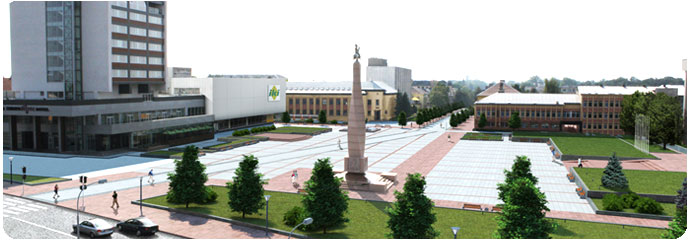MARIJAMPOLĖ CITY
Archeological finding mentioning old culture of local residents were found in Meškučiai,
Kumelionys mounds located in the territory of the city and in old villages. They give
evidence that people had lived in this land already in I century before Christ. In XIII
century a lot of castles were burned, a lot of people were killed and the remaining had
vacated Sudovia. For many years it was considered that Marijampolė city could grow from
Pašešupis village that in historical sources was firstly mentioned in 1667. The
historians also make another assumption that the predecessor of the city could be Senos
Būdos (Stara Buda) village mentioned in historical sources half a hundred year later. In
1758 the countess P. Ščiukaitė-Butlerienė had signed an official act of monastery
foundation. Shortly the monastery was built. Churchy jurisdiction was constituted and the
margins of it were indicated: Šešupė River swashes the territory from one side; Jevonis
stream swashes it from other side – from city mill till breweries. This stream flows in
Šešupė River. Foundation act had included previously existed Pašešupis village, later
Starapolė, called by the name of Marijampolė. Since the critical influence for the rise
and increase of the city had the Marion monastery, the name of the city is derived from
the Marions.
In 1792-02-23 the king of Poland and the Great Duchy of Lithuania Stanislovas Augustas
Poniatovskis had provided Marijampolė the privilege of Magdeburgas autonomy liberty and
the blazon. Marijampolė realistically became the city and important commercial center of
Užnemunė.
In the ending of XIX century and in the beginning of XX century after the government of
Russian czar had forbidden Lithuanian printing, Marijampolė becomes the center of
National movement and Užnemunė education. The unique role during this period had
Rygiškės John gymnasium. The regeneration was aroused by P. Arminas-Trupinėlis, P.
Kriaučiūnas, J. Basanavičius, J. Jablonskis, V. Kudirka, K. Grinius, J.
Matulaitis-Matulevičius many other famous people. Book smugglers had distributed illegal
printing, educative associations “Sietynas”, “Artojai”, “Šviesa” and other
took place.
During World War I and II the city was strongly blasted. During the year of Soviet
occupation a lot of people were deported to Siberia lagers. In 1941 the Germans had
destroyed Jewish community. Name Kapsukas enforced by Soviets did not naturalize to
Marijampolė. In 1989 during the first referendum organized in Lithuania the city had
retrieved its old name – Marijampolė. Although the city had experienced the occupations
of the neighbors the residents of if did not stop to cherish architectural distinction and
had tried to save remaining cultural heritage and catholic traditions.
During the time of revival the center of Christian culture, Marion’s School, theological
seminary had started to operate; religious communities and churches had been restored. In
1997-12-18 historical blazon of Marijampolė city had been restored. The monuments had
been set for the linguist J. Jablonskis, the writer V. Mykolaitis-Putinas, the raiser and
teacher of Lithuania language P. Kriaučiūnas and the defender of Independence R.
Juknevičius. The memorial in the park of Vytautas the Great was given sense to the memory
of Tauras district partisans.
In 2009 the center of the city was decorated by the monument “For the Nation, for the
Language. For mentioning of the millennium of Lithuania name 1009–2009”. In the
territory of Vytenis battalion of the Great Duchy of Lithuania the prewar monument for
duke Vytenis had been restored. In 2010 the monument for the duke of Lithuania Vytautas
the Great.
ROUTS
WALKING THROUGH MARIJAMPOLĖ
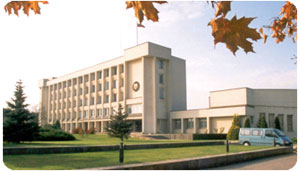 |
|
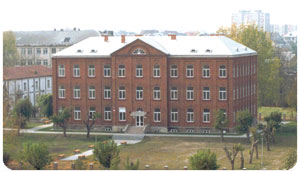 |
• Walking starts in central part of old-town, in J.
Basanavičius square. There Pašešupis village was established and first time
mentioned in 1667. At that date wooden homesteads were standing around the square. In the
course of time the village had increased into commercial Starapolė city that become
Marijampolė city later. |
|
• Through the building
of Marijampolė municipality we are going towards Poetry park and reaching Marion’s
gymnasium (J. Bendoriaus str. 7) built in 1923 during the period of historicism. |
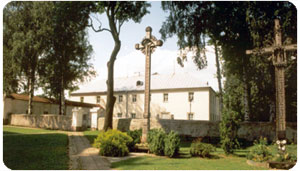 |
|
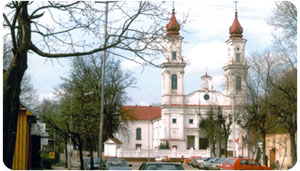 |
• Further we see Lithuanian St. George provincial
monastery of Marion’s congregation having classicistic forms, rectangular plan
(J. Bendoriaus str. 3) built around 1792. It includes protected pictures of countess P.
Ščiukaitė-Butlerienė and the founder of Marion’s institution S. Papčinskis. From
1999 to 2005 theological seminary had functioned in it. Wooden sculpture of Blessed
archbishop Jurgis Matulaitis was built.
The museum of Blessed Jurgis Matulaitis functions in the monastery. The museum delivers
excellent exposition introducing with the beginning of Marijampolė city and the history
of Marion’s monastery from the foundation of it till the closing. There authentic
documents, art ware, churchy commodities that were given to Marijampolė Marion’s
monastery by its founder countess by Pranciška Ščiukaitė – Butlerienė are exhibited
here. The main exposition “The Blessed archbishop Jurgis Matulaitis” disclose active
activity, complicated life events and deep spirituality of Jurgis Matulaitis – the
priest, bishop, archbishop, professor, monk, social player and diplomat. |
|
• St. Archangel
Michael church – Minor Basilica (J. Bendoriaus str. 1) is of classicistic,
neo-baroque forms, has two towers and three naves and was built in 1824. It conserves the
altars, pictures and chasubles. In 1934 in Sacred Heart of Jesus chapel the body of the
blessed archbishop Jurgis Matulevičius-Matulaitis was buried.
The churchyard itself includes buried Marion’s order’s general and priest V. Senkus,
other priests and the insurgents of 1831. |
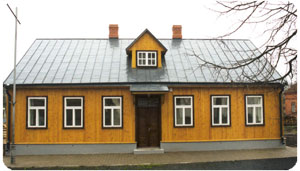 |
|
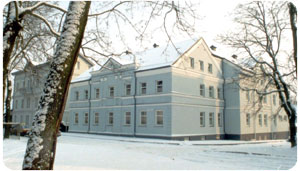 |
• The house of the President K. Grinius
(Bažnyčios str. 23). In 1902–1914 bell-ringer, the President of the Republic of
Lithuania – K. Grinius had lived there. Currently memorial museum of the President K.
Grinius takes place. |
|
• After turning from
Bažnyčios street to P. Kriaučiūno Street we approach the complex of neo-classicistic
forms buildings that had belonged to penurious sisters’ monkshood of the
Nativity of the Blessed Virgin Mary, built in XIX–XX century. |
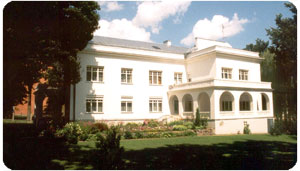 |
|
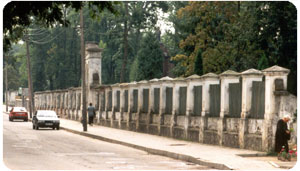 |
• At the end of P. Kriaučiūno Street there is a building
of Vilkaviškis bishopric curia of modernism forms standing that was built in
1934 in accordance to the project of famous architect V. Landsbergis-Žemkalnis. |
|
• Travel through the
park of Vytautas the Great and after turning to P. Armino Street we reach the old
cemetery of the city established in XIX century. In these cemetery there was
buried the defender of the freedom R. Juknevičius and also there were reburied a lot of
famous people: the raiser of national revival P. Arminas-Trupinėlis, writer Žemaitė,
book smugglers J. Akelaitis, J. Bliūdžius, J. Kazakevičius, A. Matulaitis and other. |
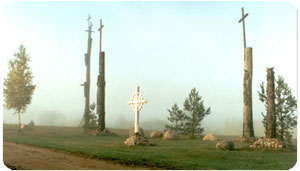 |
|
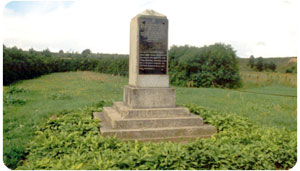 |
• The graves of Soviet terror (Varpo str.).
There used to be buried people beaten in 1944-1953. In 1990 chapel poles were set there
and Ramybės Park was appointed that includes various trees and bushes.
|
|
• 5 090 Jewries and
people of other nationality were fusilladed in Šešupė valley (near Varpo street) in
1941. |
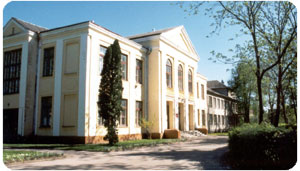 |
|
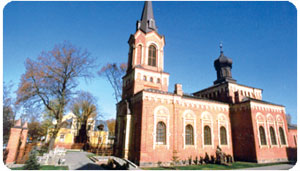 |
• After turning from the old cemetery to Vytauto Street we
approach the complex of buildings belonged to former Teacher Dom seminary
(Vytauto str. 45) and the park. These are former home of officer ship of tsarist Russian
army. Teacher Dom seminary was established in 1919. In 1944 the graves of the soldiers
were appointed there.
|
|
• St. Vincentas
Paulietis church (Vytauto str. 31A). This is single nave, single tower and
electrical, built in 1888. It is former church of orthodoxies. The church was closed in
1944. The altars and pictures were destroyed and the archive was later appointed. In
1990-1999 there were performed restoration works of the tower, belfry and rood cover,
other elements of the church and the works of environment clearing. Sculptural group
“Pieta” was uncovered in the churchyard in 2000 (sculptor J. Narušis). |
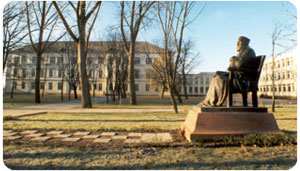 |
|
|
• After the return to J. Basanavičius square we are going
towards Kauno Street. Behind the palace of Cultural centre there is the gymnasium of Rygiškių
John standing (Kauno str. 5). The building of classicistic forms was built in
1870. Many of the pupils of this gymnasium had become famous characters of national
revival, society, nation and also famous scientists. Commemorative monument in the square
of the gymnasium was unclosed for the linguist Jonas Jablonskis in 1992 (sculptor P.
Aleksandravičius). |
|
|
Photos by Romas Linionis
SPORT
Marijampolė has deep and beautiful sport traditions. There their own way had begun a lot
of famous athletes, trainers, and sport organizers. The municipality of Marijampolė
includes 4 sport training agencies, 33 sport clubs, 5 public enterprises the activity of
which is related with physical culture and sport. Around 3500 residents of Marijampolė
exercise in these agencies. Currently 38 sport branches are being cultivated in
Marijampolė. Various international sport events are organized in Marijampolė annually
– the tournament of the greats “Suvalkijos galiūnas“, international competition of
track and field athletics “Sūduvos taurės”, competitions of hot air balloons,
automobile sport, weightlifting, boxing, basketball, football, horse sport “Premjero
taurės“ and other.
Multifunctional sport complex with football stadium of 6 000 sitting accommodations, sport
drill-hall, yards for football exercises was opened in Marijampolė in 2008. Later “ARVI
football arena” name was given to him. This is the first sport complex of such type in
Lithuania after the reinstatement of the Independence. Football stadium was built in
accordance to all requirements ascertained by UEFA. There international football
competitions can be executed.
|



